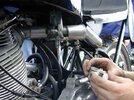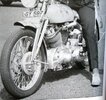Thanks for the kind words, but you have great experience with street singles. Very few owners use a dyno to check their tuning. I think Redbloke can get good answers on this forum.
Your picture is interesting and I have not tuned my intake tract length for lack of time. With the exhaust system I am running the engine does not like to run under 4300 RPM. I think I could have lowered it a few hundred rpms by lengthening the intake tract.
David
Your picture is interesting and I have not tuned my intake tract length for lack of time. With the exhaust system I am running the engine does not like to run under 4300 RPM. I think I could have lowered it a few hundred rpms by lengthening the intake tract.
David


